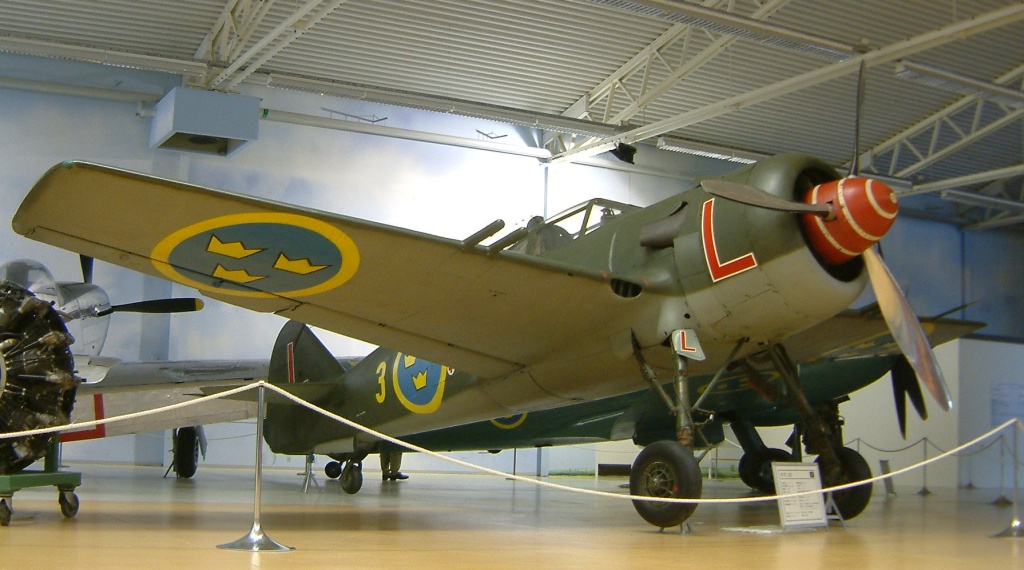- FFVS 22
infobox Aircraft
name = J 22
caption = J 22B at the Swedish Air Force Museum
type = Fighter
manufacturer = Kungliga Flygförvaltningens Flygverkstad i Stockholm (FFVS)
designer = Bo Lundberg
first flight = September 1942
introduction = October 1943
retired = 1952
status =
primary user =Swedish Air Force
produced = 1942-1946
number built = 198The FFVS J 22 was a single-engine
fighter aircraft developed for theSwedish Air Force during World War II.Development
At the onset of
World War II , theSwedish Air Force ("Flygvapnet") was equipped with largely obsoleteGloster Gladiator (J 8) biplane fighters. To augment this, Sweden ordered 120Seversky P-35 (J 9) and 144P-66 Vanguard (J 10) aircraft from the United States. However, on18 June 1940, United States declared an embargo against exporting weapons to any nation other than Great Britain. As the result, "Flygvapnet" suddenly faced a shortage of modern fighters. Several other foreign alternatives were considered: the FinnishVL Myrsky and SovietPolikarpov I-16 were unsatisfactory, and while theMitsubishi A6M Zero was available, delivery from Japan was impractical. A batch ofFiat CR.42 Falco (J 11) biplanes andReggiane Re.2000 "Falco" (J 20) were eventually purchased but this was clearly an interim solution.With "Flygvapnet" facing a serious shortage of aircraft and
Saab running at full capacity building its B 17 and B 18 bombers, a new firm and factory were established specifically for the new fighter — Kungliga Flygförvaltningens Flygverkstad i Stockholm ("Royal Air Administration Aircraft Factory in Stockholm," FFVS) underBo Lundberg . The aircraft, designated J 22, was a monoplane with aplywood -coveredsteel airframe . Wing and fuselage layout were conventional, with the narrow-track main landing gear retracting rearward entirely within the fuselage, somewhat similar to the 1935 Focke-Wulf Fw 159 parasol-wing monoplane fighter design. Power came from a Swedish copy of thePratt & Whitney R-1830 Twin Wasp, manufactured without a license at the time, though license fees were paid later.The J 22 first flew on
20 September 1942 fromBromma airport, where the factory was located. It entered service in October 1943, at the F9 air wing atGothenburg , with the last of the 198 aircraft delivered in April 1946. Sub-assemblies for the J 22 were made by over 500 different contractors.Operational history
The J 22 was well-liked by its pilots and possessed good manoeuvrability and responsive controls. Forward visibility on the ground left something to be desired and if the tailwheel was left unlocked and able to swivel during take-off there was the potential to ground-loop. In mock dogfights with
P-51 Mustang s (called J 26 in Swedish service) it was able to "hold its own" up to 5,000 metres (16,000 ft) although, above 6,000 m (19,000 ft), without a good high altitudesupercharger , it became sluggish. Because of its simple systems the J 22 was very easy to maintain and service. [ [http://www.hobbybokhandeln.se/j22/pilot.htm Pilot's views on J 22] Retrieved:22 June 2008 ]With 575 km/h (360 mph) from a 795 kW (1,065 hp) engine, the press called the diminutive fighter "World's fastest in relation to the engine power" (while not absolutely true, it was in the same class as the early marks of
Supermarine Spitfire and Zero). [ [http://www.hobbybokhandeln.se/j22/comp1000.htm Comparison with fighters 1,000 to 1,1150 hp] Retrieved:22 June 2008 ] The J 22 crews promptly modified this to "World's fastest in relation to the track width" (for which the Spitfire might also have competed), because of the very narrow wheel track. The aircraft was retired in 1952.Variants
* J 22A - first production version, 2x 7.9 mm and 2x 13.2 mm
machinegun s, 143 built. Designated J 22-1 after 1945.
* J 22B - armed with 4x 13.2 mm machine guns, 55 built. Designated J 22-2 after 1945.
* S 22 - nine J 22A equipped for reconnaissance in 1946, restored to fighters in 1947. Designated S 22-3 after 1945.Operators
;SWE
*Swedish Air Force .pecifications (J 22A)
aircraft specifications
plane or copter?=plane
jet or prop?=prop
crew=One
length main=7.80 m
length alt=25 ft 7 in
span main=10.00 m
span alt=32 ft 10 in
height main=3.60 m
height alt=11 ft 10 in
area main=16.00 m²
area alt=172.16 ft²
empty weight main=2,020 kg
empty weight alt=4,445 lb
loaded weight main=2,835 kg
loaded weight alt=6,240 lb
max takeoff weight main=
max takeoff weight alt=
engine (prop)=SFA STWC-3G
type of prop=14-cylinder air-cooledradial engine
number of props=1
power main=795 kW
power alt=1,065 hp
max speed main=575 km/h
max speed alt=360 mph
cruise speed main=340 km/h
cruise speed alt=210 mph)- Landing speed: 140 km/h (90 mph)
range main=1,270 km
range alt=790 mi
ceiling main=9,300 m
ceiling alt=30,500 ft
climb rate main=m/s
climb rate alt= ft/min
loading main=177 kg/m²
loading alt=36 lb/ft²)
power/mass main=0.28 kW/kg
power/mass alt=0.17 hp/lb
armament=
* 4x 13.2 mm (0.53 in) M/39A (Browning M2) machine gunsee also
aircontent
related=similar aircraft=
*Brewster Buffalo
*P-36 Hawk
*CAC Boomerang lists=
see also=
References
Notes
Bibliography
* Andersson, Hans G. "SAAB Aircraft since 1937; 2nd revised edition". London: Putnam Aeronautical books, 1997. ISBN 0-85177-886-0 (Note: Although dedicated to SAAB aircraft, this book has a chapter on the FFVS J 22.)
* Donald, D, Lake J. (eds.) (1996) "Encyclopedia of World Military Aircraft." AIRtime Publishing. ISBN 1-880588-24-2External links
* [http://www.ipmsstockholm.org/magazine/2002/01/stuff_eng_detail_j22.htm IPMS Stockholm's J22 "walkaround" photo series]
* [http://www.hobbybokhandeln.se/j22/index.htm J-22 history, technical data, fighter comparisons, colours and markings] Retrieved:23 June 2008 - Landing speed: 140 km/h (90 mph)
Wikimedia Foundation. 2010.
